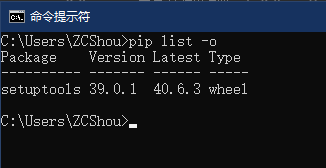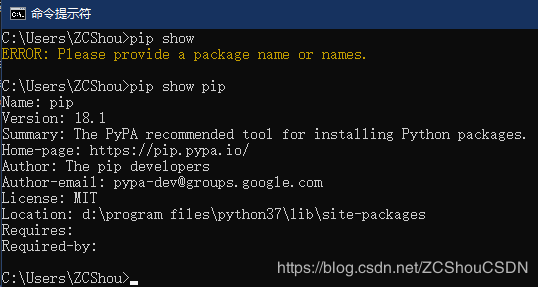您好,登錄后才能下訂單哦!
您好,登錄后才能下訂單哦!
小編給大家分享一下Python中pip怎么用,相信大部分人都還不怎么了解,因此分享這篇文章給大家參考一下,希望大家閱讀完這篇文章后大有收獲,下面讓我們一起去了解一下吧!
其實,pip就是 Python標準庫(The Python Standard Library)中的一個包,這個包比較特殊,用它可以來管理Python標準庫(The Python Standard Library)中其他的包。pip支持從PyPI(https://pypi.org/ ),版本控制,本地項目以及直接從分發文件進行安裝。pip是一個命令行程序。 安裝pip后,會向系統添加一個pip命令,該命令可以從命令提示符運行。
目前,pip 是The Python Packaging Authority (PyPA) 推薦的 Python 包管理工具!
The Python Packaging Authority (PyPA) is a working group that maintains many of the relevant projects in Python packaging.
從 Python 2 版本 >=2.7.9 或 Python 3 版本 >=3.4 開始,官網的安裝包中已經自帶了 pip,在安裝時用戶可以直接選擇安裝。或者如果使用由 virtualenv 或者 pyvenv 創建的 Virtual Environment,那么 pip 也是被默認安裝的。
如果沒有在安裝python時候,選擇上"安裝pip"選項,那么也可以從本地安裝。例如,直接使用get-pip.py進行安裝。
首先從官網下載get-pip.py;
然后直接運行python get-pip.py即可;
安裝后,在命令行中鍵入:pip+ 回車,就會出現如下使用說明:
Usage: pip <command> [options] Commands: install Install packages. download Download packages. uninstall Uninstall packages. freeze Output installed packages in requirements format. list List installed packages. show Show information about installed packages. check Verify installed packages have compatible dependencies. config Manage local and global configuration. search Search PyPI for packages. wheel Build wheels from your requirements. hash Compute hashes of package archives. completion A helper command used for command completion. help Show help for commands. General Options: -h, --help Show help. --isolated Run pip in an isolated mode, ignoring environment variables and user configuration. -v, --verbose Give more output. Option is additive, and can be used up to 3 times. -V, --version Show version and exit. -q, --quiet Give less output. Option is additive, and can be used up to 3 times (corresponding to WARNING, ERROR, and CRITICAL logging levels). --log <path> Path to a verbose appending log. --proxy <proxy> Specify a proxy in the form [user:passwd@]proxy.server:port. --retries <retries> Maximum number of retries each connection should attempt (default 5 times). --timeout <sec> Set the socket timeout (default 15 seconds). --exists-action <action> Default action when a path already exists: (s)witch, (i)gnore, (w)ipe, (b)ackup, (a)bort). --trusted-host <hostname> Mark this host as trusted, even though it does not have valid or any HTTPS. --cert <path> Path to alternate CA bundle. --client-cert <path> Path to SSL client certificate, a single file containing the private key and the certificate in PEM format. --cache-dir <dir> Store the cache data in <dir>. --no-cache-dir Disable the cache. --disable-pip-version-check Don't periodically check PyPI to determine whether a new version of pip is available for download. Implied with --no-index. --no-color Suppress colored output
pip命令組合比較靈活,下面重點介紹幾個。
命令行直接鍵入pip install + 回車,則 出現如下提示:ERROR: You must give at least one requirement to install (see "pip help install")。接著我們鍵入pip help install,就會出現pip install的使用說明了,如下:
Usage: pip install [options] <requirement specifier> [package-index-options] ... pip install [options] -r <requirements file> [package-index-options] ... pip install [options] [-e] <vcs project url> ... pip install [options] [-e] <local project path> ... pip install [options] <archive url/path> ... Description: Install packages from: - PyPI (and other indexes) using requirement specifiers. - VCS project urls. - Local project directories. - Local or remote source archives. pip also supports installing from "requirements files", which provide an easy way to specify a whole environment to be installed. Install Options: -r, --requirement <file> Install from the given requirements file. This option can be used multiple times. -c, --constraint <file> Constrain versions using the given constraints file. This option can be used multiple times. --no-deps Don't install package dependencies. --pre Include pre-release and development versions. By default, pip only finds stable versions. -e, --editable <path/url> Install a project in editable mode (i.e. setuptools "develop mode") from a local project path or a VCS url. -t, --target <dir> Install packages into <dir>. By default this will not replace existing files/folders in <dir>. Use --upgrade to replace existing packages in <dir> with new versions. --platform <platform> Only use wheels compatible with <platform>. Defaults to the platform of the running system. --python-version <python_version> Only use wheels compatible with Python interpreter version <version>. If not specified, then the current system interpreter minor version is used. A major version (e.g. '2') can be specified to match all minor revs of that major version. A minor version (e.g. '34') can also be specified. --implementation <implementation> Only use wheels compatible with Python implementation <implementation>, e.g. 'pp', 'jy', 'cp', or 'ip'. If not specified, then the current interpreter implementation is used. Use 'py' to force implementation-agnostic wheels. --abi <abi> Only use wheels compatible with Python abi <abi>, e.g. 'pypy_41'. If not specified, then the current interpreter abi tag is used. Generally you will need to specify --implementation, --platform, and --python-version when using this option. --user Install to the Python user install directory for your platform. Typically ~/.local/, or %APPDATA%\Python on Windows. (See the Python documentation for site.USER_BASE for full details.) --root <dir> Install everything relative to this alternate root directory. --prefix <dir> Installation prefix where lib, bin and other top-level folders are placed -b, --build <dir> Directory to unpack packages into and build in. Note that an initial build still takes place in a temporary directory. The location of temporary directories can be controlled by setting the TMPDIR environment variable (TEMP on Windows) appropriately. When passed, build directories are not cleaned in case of failures. --src <dir> Directory to check out editable projects into. The default in a virtualenv is "<venv path>/src". The default for global installs is "<current dir>/src". -U, --upgrade Upgrade all specified packages to the newest available version. The handling of dependencies depends on the upgrade-strategy used. --upgrade-strategy <upgrade_strategy> Determines how dependency upgrading should be handled [default: only-if-needed]. "eager" - dependencies are upgraded regardless of whether the currently installed version satisfies the requirements of the upgraded package(s). "only-if-needed" - are upgraded only when they do not satisfy the requirements of the upgraded package(s). --force-reinstall Reinstall all packages even if they are already up-to-date. -I, --ignore-installed Ignore the installed packages (reinstalling instead). --ignore-requires-python Ignore the Requires-Python information. --no-build-isolation Disable isolation when building a modern source distribution. Build dependencies specified by PEP 518 must be already installed if this option is used. --install-option <options> Extra arguments to be supplied to the setup.py install command (use like --install-option="-- install-scripts=/usr/local/bin"). Use multiple --install-option options to pass multiple options to setup.py install. If you are using an option with a directory path, be sure to use absolute path. --global-option <options> Extra global options to be supplied to the setup.py call before the install command. --compile Compile Python source files to bytecode --no-compile Do not compile Python source files to bytecode --no-warn-script-location Do not warn when installing scripts outside PATH --no-warn-conflicts Do not warn about broken dependencies --no-binary <format_control> Do not use binary packages. Can be supplied multiple times, and each time adds to the existing value. Accepts either :all: to disable all binary packages, :none: to empty the set, or one or more package names with commas between them. Note that some packages are tricky to compile and may fail to install when this option is used on them. --only-binary <format_control> Do not use source packages. Can be supplied multiple times, and each time adds to the existing value. Accepts either :all: to disable all source packages, :none: to empty the set, or one or more package names with commas between them. Packages without binary distributions will fail to install when this option is used on them. --prefer-binary Prefer older binary packages over newer source packages. --no-clean Don't clean up build directories. --require-hashes Require a hash to check each requirement against, for repeatable installs. This option is implied when any package in a requirements file has a --hash option. --progress-bar <progress_bar> Specify type of progress to be displayed [off|on|ascii|pretty|emoji] (default: on) Package Index Options: -i, --index-url <url> Base URL of Python Package Index (default https://pypi.org/simple). This should point to a repository compliant with PEP 503 (the simple repository API) or a local directory laid out in the same format. --extra-index-url <url> Extra URLs of package indexes to use in addition to --index-url. Should follow the same rules as --index-url. --no-index Ignore package index (only looking at --find-links URLs instead). -f, --find-links <url> If a url or path to an html file, then parse for links to archives. If a local path or file:// url that's a directory, then look for archives in the directory listing. --process-dependency-links Enable the processing of dependency links. General Options: -h, --help Show help. --isolated Run pip in an isolated mode, ignoring environment variables and user configuration. -v, --verbose Give more output. Option is additive, and can be used up to 3 times. -V, --version Show version and exit. -q, --quiet Give less output. Option is additive, and can be used up to 3 times (corresponding to WARNING, ERROR, and CRITICAL logging levels). --log <path> Path to a verbose appending log. --proxy <proxy> Specify a proxy in the form [user:passwd@]proxy.server:port. --retries <retries> Maximum number of retries each connection should attempt (default 5 times). --timeout <sec> Set the socket timeout (default 15 seconds). --exists-action <action> Default action when a path already exists: (s)witch, (i)gnore, (w)ipe, (b)ackup, (a)bort). --trusted-host <hostname> Mark this host as trusted, even though it does not have valid or any HTTPS. --cert <path> Path to alternate CA bundle. --client-cert <path> Path to SSL client certificate, a single file containing the private key and the certificate in PEM format. --cache-dir <dir> Store the cache data in <dir>. --no-cache-dir Disable the cache. --disable-pip-version-check Don't periodically check PyPI to determine whether a new version of pip is available for download. Implied with --no-index. --no-color Suppress colored output
上面一大堆,總結來說,安裝命令就是:pip install <包名> 或 pip install -r requirements.txt(對于本地安裝包可以指定路徑)。唯一需要特殊說明的是,安裝時可以指定版本號來安裝,舉例如下:
pip install SomePackage # 最新版本 pip install SomePackage==1.0.4 # 指定版本 pip install 'SomePackage>=1.0.4' # 最小版本
卸載安裝包命令:pip uninstall <包名> 或 pip uninstall -r requirements.txt
pip install -U <包名> 或:pip install <包名> --upgrade
pip freeze,查看已經安裝的包及版本信息。導出到指定文件中,如圖,注意 “ > ”,文件名稱隨意。常見按第二種寫法。
列出當前已經安裝的包。使用命令pip list -o則可查詢可升級的包。

顯示包所在目錄及信息,格式為:pip show <包名>。如果不加包名,則提示ERROR: Please provide a package name or names.。

搜索包,格式為:pip search <搜索關鍵字>。如果不寫關鍵字,則提示ERROR: Missing required argument (search query).。

以上是“Python中pip怎么用”這篇文章的所有內容,感謝各位的閱讀!相信大家都有了一定的了解,希望分享的內容對大家有所幫助,如果還想學習更多知識,歡迎關注億速云行業資訊頻道!
免責聲明:本站發布的內容(圖片、視頻和文字)以原創、轉載和分享為主,文章觀點不代表本網站立場,如果涉及侵權請聯系站長郵箱:is@yisu.com進行舉報,并提供相關證據,一經查實,將立刻刪除涉嫌侵權內容。